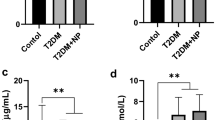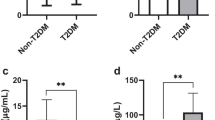Abstract
Purpose
Serum C1q/TNF-related protein-12 (CTRP12) is one of the newly studied families of adipokines, which is believed to be associated with type 2 diabetes. However, the relationship between serum CTRP12 levels and diabetic nephropathy remains unclear. This study aimed to investigate the relationship between serum CTRP12 levels and renal function in patients with type 2 diabetes.
Methods
A total of 115 type 2 diabetic patients and 54 healthy subjects were enrolled in this study. 52 patients with type 2 diabetes were in the diabetes group (T2DM). The 63 patients with renal dysfunction were diabetic nephropathy group (T2DM-DN) and were divided into microalbuminuria subgroup (31 cases) and macroalbuminuria subgroup (32 cases) according to the 24-h urine protein excretion rate. The concentrations of serum CTRP12 were determined by enzyme-linked immunosorbent assay.
Results
Serum CTRP12 level in T2DM and T2DM-DN groups was significantly lower compared with the control group, while CTRP12 level in T2DM-DN group was significantly lower than that in T2DM group, and was associated with the severity of renal insufficiency. After adjusting for gender and age, serum CTRP12 level was negatively correlated with the duration of diabetes, blood urea nitrogen (BUN), uric acid (UA) and 24-h urinary albumin excretion rate (UAE) in T2DM patients. Logistic regression analysis showed that serum CTRP12 level was significantly associated with renal dysfunction in type 2 diabetes mellitus. And the duration of diabetes, total cholesterol (CHOL) and neutrophils/lymphocytes (NLR) are independent risk factors for renal dysfunction in type 2 diabetes mellitus.
Conclusion
Serum CTRP12 may be involved in the occurrence and development of diabetic nephropathy.
Trial registration number and date of registration ChiCTR2000030794, March 14, 2020.


Similar content being viewed by others
Availability of data and materials
All data and materials in this study are truly available.
References
Hausmann J, Waechtershaeuser A, Behnken I et al (2019) The role of adipokines in the improvement of diabetic and cardiovascular risk factors within a 52-week weight-loss programme for obesity. Obes Res Clin Pract 13:440–447
Lau WB, Ohashi K, Wang Y et al (2017) Role of adipokines in cardiovascular disease. Circ J 81:920–928
Wong GW, Krawczyk SA, Kitidis-Mitrokostas C et al (2008) Molecular, biochemical and functional characterizations of C1q/TNF family members: adipose-tissue-selective expression patterns, regulation by PPAR-gamma agonist, cysteine-mediated oligomerizations, combinatorial associations and metabolic functions. Biochem J 416:161–177
Schaffler A, Buechler C (2012) CTRP family: linking immunity to metabolism. Trends Endocrinol Metab 23:194–204
Wei Z, Peterson JM, Lei X et al (2012) C1q/TNF-related protein-12 (CTRP12), a novel adipokine that improves insulin sensitivity and glycemic control in mouse models of obesity and diabetes. J Biol Chem 287:10301–10315
Enomoto T, Ohashi K, Shibata R et al (2011) Adipolin/C1qdc2/CTRP12 protein functions as an adipokine that improves glucose metabolism. J Biol Chem 286:34552–34558
Xu Y, Wang L, He J et al (2013) Prevalence and control of diabetes in Chinese adults. JAMA 310:948–959
Kim Y, Lim JH, Kim MY et al (2018) The adiponectin receptor agonist adiporon ameliorates diabetic nephropathy in a model of type 2 diabetes. J Am Soc Nephrol 29:1108–1127
Moradi N, Fadaei R, Khamseh ME et al (2019) Serum levels of CTRP3 in diabetic nephropathy and its relationship with insulin resistance and kidney function. PLoS ONE 14:e0215617
Colman PG, Thomas DW, Zimmet PZ et al (1999) New classification and criteria for diagnosis of diabetes mellitus. The Australasian Working Party on Diagnostic Criteria for Diabetes Mellitus. N Z Med J 112:139–141
Levey AS, Stevens LA (2010) Estimating GFR using the CKD Epidemiology Collaboration (CKD-EPI) creatinine equation: more accurate GFR estimates, lower CKD prevalence estimates, and better risk predictions. Am J Kidney Dis 55:622–627
Fadaei R, Moradi N, Kazemi T et al (2019) Decreased serum levels of CTRP12/adipolin in patients with coronary artery disease in relation to inflammatory cytokines and insulin resistance. Cytokine 113:326–331
Shanaki M, Moradi N, Fadaei R et al (2018) Lower circulating levels of CTRP12 and CTRP13 in polycystic ovarian syndrome: irrespective of obesity. PLoS ONE 13:e0208059
Bai B, Ban B, Liu Z et al (2017) Circulating C1q complement/TNF-related protein (CTRP) 1, CTRP9, CTRP12 and CTRP13 concentrations in Type 2 diabetes mellitus: in vivo regulation by glucose. PLoS ONE 12:e0172271
Tan BK, Chen J, Hu J et al (2014) Circulatory changes of the novel adipokine adipolin/CTRP12 in response to metformin treatment and an oral glucose challenge in humans. Clin Endocrinol (Oxf) 81:841–846
Tan BK, Lewandowski KC, O’Hare JP et al (2014) Insulin regulates the novel adipokine adipolin/CTRP12: in vivo and ex vivo effects. J Endocrinol 221:111–119
Hu TY, Li LM, Pan YZ (2019) CTRP3 inhibits high glucose-induced human glomerular mesangial cell dysfunction. J Cell Biochem 120:5729–5736
Barbieri D, Goicoechea M et al (2019) Obesity and chronic kidney disease progression-the role of a new adipocytokine: c1q/tumour necrosis factor-related protein-1. Clin Kidney J 12:420–426
Yi W, OuYang Q (2019) Adiponectin improves diabetic nephropathy by inhibiting necrotic apoptosis. Arch Med Sci 15:1321–1328
Woziwodzka K, Dziewierz A, Pawica M et al (2019) Neutrophil-to-lymphocyte ratio predicts long-term all-cause mortality in patients with chronic kidney disease stage 5. Folia Med Cracov 59:55–70
Onalan E, Gozel N, Donder E (2019) Can hematological parameters in type 2 diabetes predict microvascular complication development? Pak J Med Sci 35:1511–1515
Chai T, Zhang D, Li Z (2018) Analysis on influencing factors of abnormal renal function in elderly patients with type 2 diabetes mellitus. Minerva Endocrinol. 45(1):12–17
Aronson D, Mittleman MA, Burger AJ (2004) Elevated blood urea nitrogen level as a predictor of mortality in patients admitted for decompensated heart failure. Am J Med 116:466–473
Funding
This study was sponsored by the National Natural Science Foundation of China (81202189) and the Natural Science Foundation of Heilongjiang Province (H2016040).
Author information
Authors and Affiliations
Contributions
Conceptualization, HZ; methodology, JD; formal analysis and investigation, JD, XW, YL, XZ; writing original draft preparation, JD; writing–review and editing, JD; data analysis, JX; funding acquisition, HZ; resources, HZ; supervision, HZ.
Corresponding author
Ethics declarations
Conflict of interest
The authors declare that they have no conflict of interest.
Ethics approval
This study was approved by the ethics committee of the first affiliated hospital of Harbin medical university. The procedures used in this study adhere to the tenets of the Declaration of Helsinki.
Code availability
In this study, SPSS17.0 (IBM,USA) statistical software was used for data analysis.
Consent to participate
Informed consent was obtained from all individual participants included in the study.
Consent for publication
Patients signed informed consent regarding publishing their data.
Additional information
Publisher's Note
Springer Nature remains neutral with regard to jurisdictional claims in published maps and institutional affiliations.
Rights and permissions
About this article
Cite this article
Du, J., Xu, J., Wang, X. et al. Reduced serum CTRP12 levels in type 2 diabetes are associated with renal dysfunction. Int Urol Nephrol 52, 2321–2327 (2020). https://doi.org/10.1007/s11255-020-02591-y
Received:
Accepted:
Published:
Issue Date:
DOI: https://doi.org/10.1007/s11255-020-02591-y




